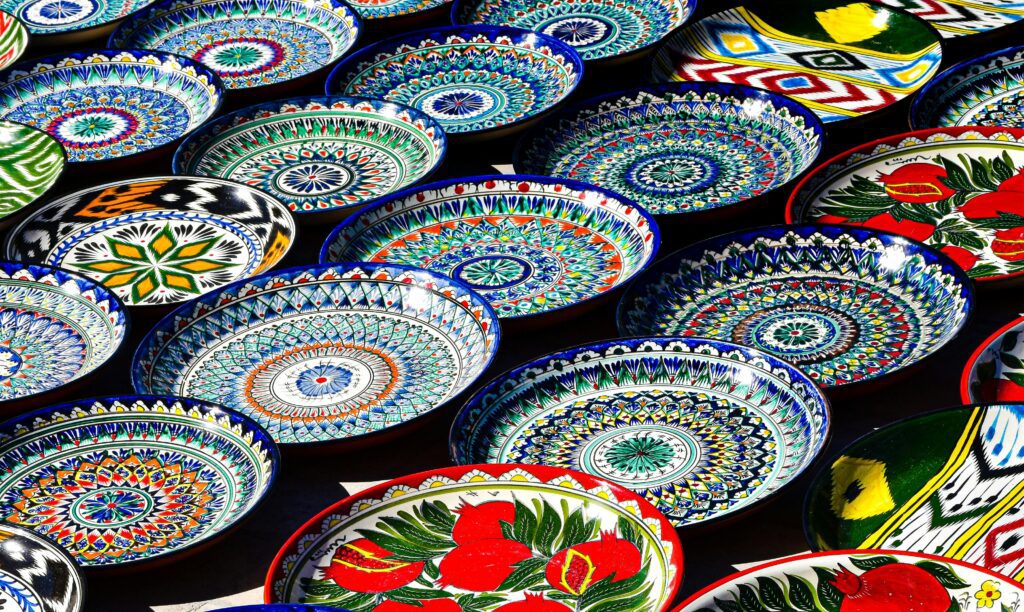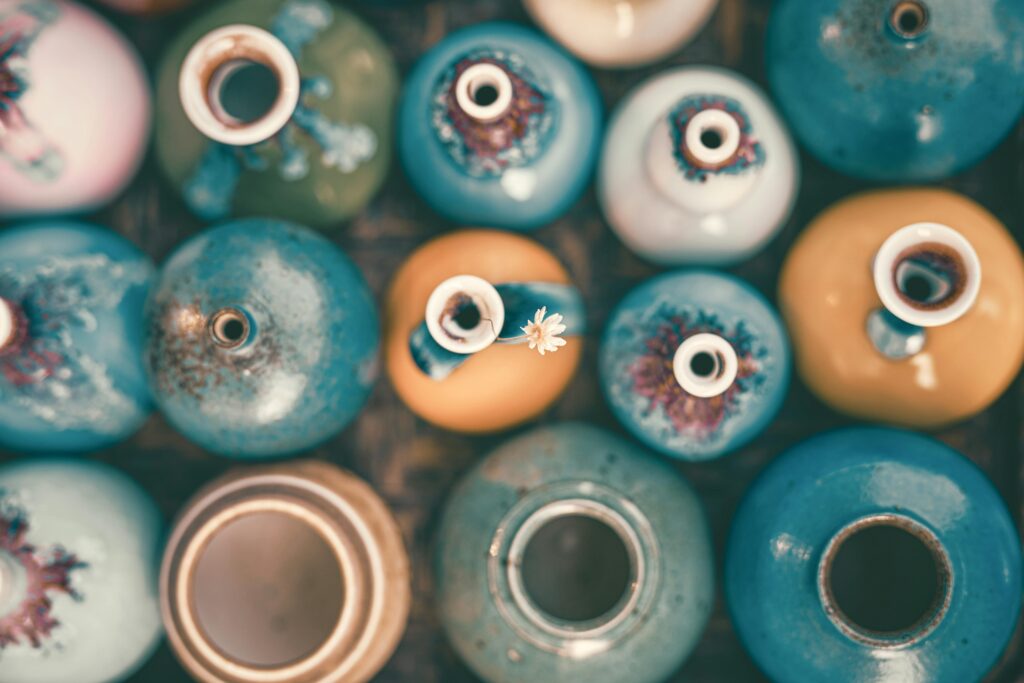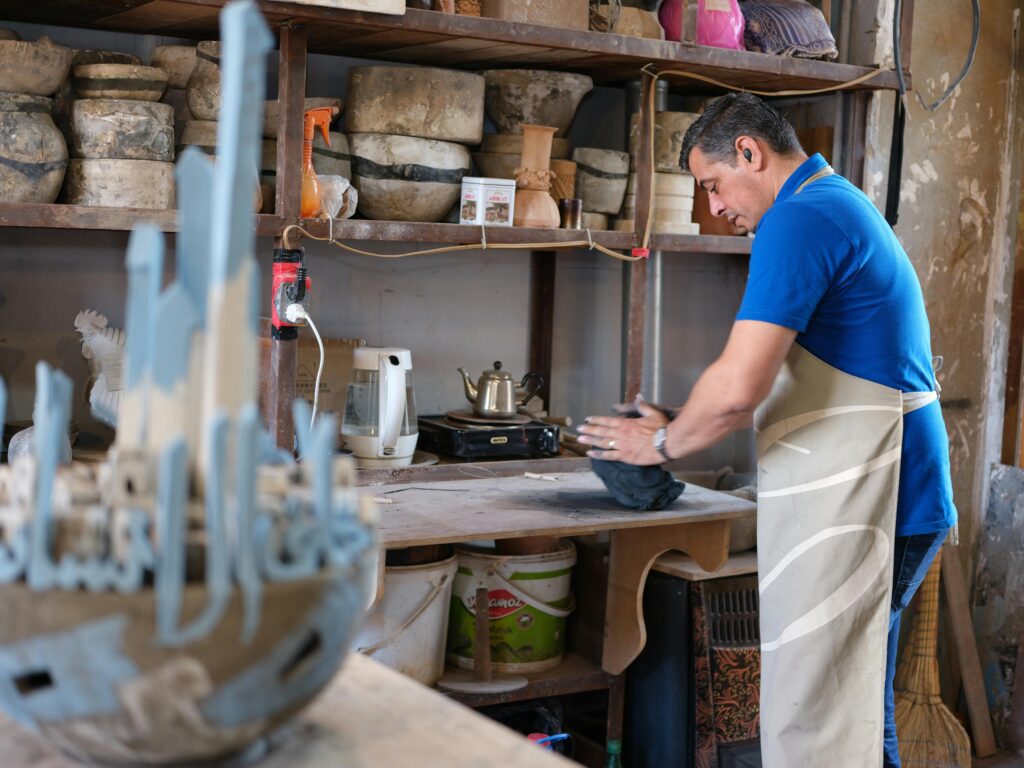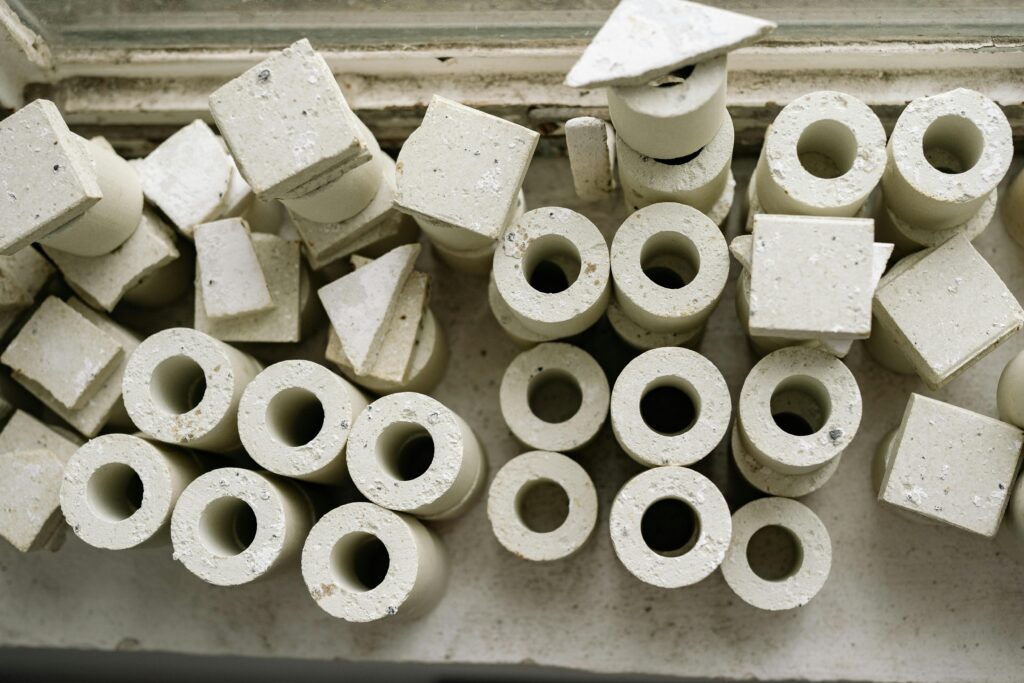
Table of Contents
Introduction
Jaipur, India’s Pink City, is renowned for its richly colored culture, majestic forts, and exquisitely created art. Of its many wonders, blue pottery of Jaipur is one of the most mysterious and lovely pieces of art.
In contrast to the traditional clay pottery, this technique combines quartz, powdered glass, and natural pigments to create delicate but long-lasting pieces.
Its timeless cobalt-blue hue, subtle patterns, and glossy finish render it instantly recognizable.
Blue pottery has emerged as the icon of Jaipur’s art legacy of the past centuries. Blue pottery decorated tiles and wall panels, sophisticated vases and tabletops, homes, palaces, and temples.
Here in this article, we go through the 7 stunning blue pottery designs that art lovers and collectors simply cannot have enough of.
We will also find out how it came into being, the techniques applied, its significance from a cultural point of view, and how to preserve these wonderful works of art.
History of Blue Pottery of Jaipur
The blue pottery of Jaipur carries with it a fascinating legacy that spans centuries, cultures, and continents.
Its story is not just about artistic expression but also about the fusion of civilizations — where Persian elegance met Rajasthani creativity to create one of India’s most distinctive art forms.
Origins and Early Influences
The roots of blue pottery can be traced back to the ancient lands of Persia, Turkey, and Central Asia, where artisans perfected the art of glazing pottery using quartz and natural minerals.
This craft gradually traveled through the Silk Route, eventually reaching India during the Mughal era.
The Mughals, known for their love of beauty and architecture, encouraged the art of tile-making and ornamentation — often seen in the intricate blue tiles of their mosques, tombs, and palaces.
It is believed that the technique was introduced to India during the 14th century and gained prominence under the patronage of Mughal emperors.
However, it was during the 18th century that this craft found its true home in Jaipur, thanks to royal encouragement and the skilled hands of local artisans.
Adoption in Jaipur
When blue pottery arrived in Rajasthan, it encountered a land already rich in artistic traditions — from miniature painting and gemstone work to metal engraving and textiles.
The rulers of Jaipur, especially Maharaja Sawai Ram Singh II, saw immense potential in this delicate art form and invited Persian-trained artisans to teach local craftsmen.
Under royal patronage, Jaipur became the nucleus of blue pottery production.
The artisans infused traditional Persian motifs with Indian aesthetics — peacocks, elephants, lotus flowers, and intricate geometric patterns — giving rise to a distinct Jaipur style that blended East and West seamlessly.
Unlike conventional pottery, which uses clay, Jaipur’s blue pottery introduced a unique mixture of quartz, powdered glass, fuller’s earth, borax, and gum.
This innovation made the pottery not only visually captivating but also translucent and durable, setting it apart from other ceramic arts of the time.
Evolution Through the Centuries
As the centuries passed, the blue pottery of Jaipur continued to evolve. Initially reserved for royal courts and temples, it slowly found its way into common households.
Artisans began crafting not just tiles and wall panels, but also bowls, vases, plates, and household items, blending utility with artistry.
During the colonial period, interest in Indian handicrafts surged among European travelers and traders.
Blue pottery from Jaipur became a prized collectible, admired for its smooth glaze, intricate designs, and exotic colors.
However, as industrialization took hold in the 20th century, many traditional crafts—including blue pottery—faced decline due to competition from mass-produced goods.r
Revival of Blue Pottery in Jaipur
By the mid-20th century, this age-old craft was on the brink of extinction. Fortunately, a few visionaries stepped forward to preserve it.
Notably, Kripal Singh Shekhawat, a renowned artist and art educator, played a pivotal role in reviving blue pottery.
With support from the Maharaja of Jaipur and various art institutions, Shekhawat trained new generations of artisans and modernized designs while retaining traditional techniques.
Art schools and NGOs began promoting blue pottery through exhibitions, workshops, and collaborations with contemporary designers.
This revival not only saved the craft from disappearing but also brought it into the limelight as a symbol of sustainable, handcrafted art.
Blue Pottery in Modern Times
Today, the blue pottery of Jaipur has become an integral part of India’s artistic identity. It is recognized globally for its unique blend of Persian, Mughal, and Rajasthani influences.

Artisans in Jaipur continue to create stunning pieces that maintain the traditional hand-painting techniques, yet cater to modern aesthetics.
Contemporary designers have also embraced this traditional art form, incorporating blue pottery elements into home décor, architecture, jewelry, and even fashion accessories.
Many design houses now collaborate directly with artisans, ensuring fair trade practices and sustainable livelihoods.
In 2015, the Geographical Indication (GI) tag was granted to Jaipur Blue Pottery, officially recognizing it as a product unique to this region.
This acknowledgment not only protects its authenticity but also celebrates the resilience of the artisans who have kept the tradition alive through generations.
Cultural Significance and Legacy
The history of blue pottery of Jaipur is a testament to the enduring spirit of craftsmanship and cultural exchange.
It reflects how art can transcend boundaries, evolving through centuries while retaining its soul.
Each handcrafted piece embodies the patience, precision, and passion of artisans who transform simple materials into timeless beauty.
From adorning royal palaces to gracing modern homes across the world, Jaipur’s blue pottery continues to enchant with its mesmerizing hues, delicate designs, and cultural depth.
It remains a proud symbol of Rajasthan’s artistic heritage — a living link between the past and present, between tradition and innovation.
Materials and Techniques Used
Differently from the conventional clay pottery, the blue pottery is produced by a unique mixture of fuller’s earth, powdered glass, quartz powder, and natural pigments.

The mixture is kneaded softly into a pliable dough, which is shaped into various forms using molds or hand work techniques.
Following the shaping of the piece, it is sun-dried and painted with natural mineral-based paints, the majority of which is cobalt blue.
The remaining colors such as green, yellow, and brown are also used to enhance the design further. The painted works are then fired at high temperatures to achieve the classic glossy finish.
The meticulous process of producing Jaipur blue pottery requires patience, skill, and attention to detail.
The products are crafted wholly by hand, therefore no two products will be the same. This kind of devotion to craftsmanship is what gives Jaipur’s pottery value and worth.
Significance of Blue Pottery in Jaipur Society
Blue pottery is not just a decorative art form; it is heavily infused with Jaipur culture. It was originally employed in royal courts and palaces to exhibit wealth, sophistication, and refinement. I
ts intricate patterns often find inspiration in Rajasthani motifs like floral life, animals, and geometric patterns.
During the modern age, Jaipur blue pottery has become a synonym for Jaipur’s art history.
Blue pottery is utilized in home decoration, during festivals, and as presents during cultural events. The blue color, due to cobalt oxide, is believed to symbolize peace, wisdom, and harmony.
Owning a piece of Jaipur pottery is considered a way of becoming a part of Jaipur’s glorious past and art.
7 Stunning Blue Pottery Designs You’ll Absolutely Love
5.1 Floral Motifs
Floral patterns are the most iconic and widely recognized designs in blue pottery of Jaipur.
Inspired by nature and Mughal miniature paintings, these motifs often feature flowers like lotuses, roses, marigolds, and vines with elaborate detailing.
The cobalt blue color highlights the delicate patterns, creating a striking visual contrast against the pale background.
Floral pottery is typically used in vases, plates, and ornamental tiles. Every flower is hand-painted with delicate shading and layers of color, reflecting the craftsman’s expertise.
In addition to design, floral patterns represent prosperity, harmony, and development, hence their use in homes and ceremonial presents.
Example: A Jaipur blue pottery vase filled with lotus flowers arranged against curled vines can brighten up any office or living room.
The intricate layering of color and delicate brushwork produces depth, and every piece is a miniature masterpiece.
5.2 Geometric Patterns
Geometric patterns are yet another characteristic of Jaipur’s blue pottery. These designs are skillfully computed to ensure symmetry, proportion, and balance. Circles, triangles, squares, and hexagons are brought together with fine lines in a hypnotic rhythm.
Geometric pottery is traditionally used for tiles, coasters, and wall panels. These patterns are favored by new and old tastes because they are timeless and versatile.

The precision required with geometric designs reflects the skill of the craftsman, as a small mistake will ruin the symmetry.
Example: A repeated hexagonal motif panel in cobalt blue and white can be used as a show-stopping centerpiece in a living room or courtyard.
Geometric designs also dominate floor tiles in heritage buildings, where functionality is equalled by beauty.
5.3 Animal and Bird Designs
Animals and birds have been a part of Jaipur’s painting history for long. Jaipur blue pottery typically brings peacocks, elephants, camels, horses, and exotic birds to life, celebrating the richness of Rajasthan’s wildlife and folk tales.
Each animal is painted in amazing detail, having an influence on movement, expression, and texture.
These motifs are not only decorative but also symbolic. Peacock, for instance, represents beauty and grace, and elephants represent strength and prosperity.
Bowls, trays, and wall decorations bearing animal and bird motifs are highly sought after by collectors and connoisseurs of culture.
Example: A decorative plate of a royal elephant with intricate ornaments in cobalt and green hues can serve both functions and also be a collector’s item of art.
5.4 Contemporary Fusion
Though the conventional designs remain popular, modern artisans have begun experimenting with novel fusion designs.
These include abstract designs, minimalist shapes, and lively color combinations that blend Jaipur’s heritage with modernistic tastes. This keeps blue pottery updated in modern interiors and captures global customers’ attention.
Fusion ceramics usually consist of non-conventional forms, such as asymmetrical vases, geometrically-shaped bowls, or abstract wall pieces. The combination of traditional cobalt blue with metallic and pastel colors has a stunning visual effect.
Example: A series of asymmetrical vases with abstract cobalt, gold, and white splatters can become a highlight in modern homes or offices, combining artistic heritage with contemporary styles of décor.
5.5 Tiles and Wall Art
The most versatile and visually appealing application of Jaipur’s blue pottery is in wall hangings and tiles. Decorative panels, kitchen backsplashes, bathroom walls, and even floors can be used with hand-painted tiles.
All tiles are meticulously handmade and tend to feature floral, geometric, or bird motifs.
Blue pottery’s durability ensures such decorative items remain vibrant for years, not fading away and getting worn out. Artisans usually prepare tile sets having a narrative or with unbroken patterns, adding a narrative in architectural spaces.
For instance, a tile wall in the courtyard featuring intertwined floral and geometric motifs can be a gorgeous backdrop for a garden or seating area, honoring Jaipur’s cultural heritage.
5.6 Tableware and Utensils
Other than decoration, Jaipur blue pottery is used widely in functional items. Plates, bowls, trays, jars, and tea sets serve purpose and aesthetics. The shine and cobalt brightness make a daily meal a visual treat.
Patterns on tableware typically include floral, geometric, or native Rajasthani patterns. Artisans take extreme care with proportion, weight, and equilibrium so that every item becomes a pleasure to use and not merely a thing to look at.
Example: A cobalt blue hand-painted floral pattern serving dish can complement food presentation along with Jaipur’s skill. Similarly, jars with peacock designs can be employed for decoration and usage in the kitchen.
5.7 Jewelry and Miniature Art Pieces
Besides large decorative pieces and utilitarian ware, Jaipur blue pottery is fashioned into stunning miniature art pieces and jewelry.
These come in the shapes of pendants, earrings, miniature plates, and figurines, all having the city’s traditional cobalt blue and intricate designs.
Miniature pottery allows collectors, as well as art enthusiasts, to possess Jaipur’s heritage in something small, wherein they do not need huge display spaces.
Jewelry pieces, often combined with metalwork, incorporate blue pottery’s loveliness into wearable art.
Example: A hand-painted peacock or floral theme on a pendant piece in cobalt blue and white can serve as an icebreaker while retaining the craftsmanship of Jaipur’s artisans without sacrificing a large space.
This extended section provides readers with a thorough comprehension of every design style, its cultural context, and real-life examples, naturally incorporating your main and LSI keywords along the way.
Where to Buy Authentic Blue Pottery in Jaipur
In order to feel the real magic of blue pottery, one has to buy from trusted sources. Johari Bazaar, Bapu Bazaar, and MI Road are among the popular markets in Jaipur that provide ample options for original pottery products.
Workshops of artisans and art galleries are also great destinations to discover original designs.
Jaipur Blue Pottery Art Centre
Situated on Amer Road, this center is not to be missed by enthusiasts in search of authentic blue pottery.
Founded by craftsmen with experience of over eight generations, it has a comprehensive collection of over 350 ornament and utility items.
Individuals can view the intricate process of making it themselves, hence making it an educational outing as well.
Tripadvisor
Johari Bazaar
Situated in the middle of Jaipur, Johari Bazaar is renowned for its vibrant markets. Even though it’s most famous for jewellery, there are a number of shops here that also sell blue pottery.
The area offers a combination of old and new designs, with something for everyone.
Jaipur Unveiled
Tripolia Bazaar
Famous for brassware and fabric, Tripolia Bazaar also has some family-run shops for blue pottery hand-painted items.
It’s a great place for collectors looking for something out of the ordinary that captures Jaipur’s rich heritage.
Jaipur Unveiled
Bapu Bazaar
A vibrant market renowned for fabrics and handicrafts, Bapu Bazaar has some particularly selected shops offering blue pottery items at reasonable prices.
It’s ideal for those who wish to purchase souvenirs or presents without taxing their budgets.
MI Road
Surrounded by high-end handicraft emporiums, MI Road is ideal for those seeking high-quality, fixed price Jaipur blue pottery items.
The stores here boast regular quality checks so that customers get genuine products.
Jaipur Unveiled
The India Craft House (Online)
For those unable to make it to Jaipur themselves, The India Craft House has a judiciously curated line of Jaipur blue pottery products available online.
From serving dishes to ornaments, all products are handcrafted by artisans to ensure authenticity.
The India Craft House
Hastkala Jaipur
Hastkala Jaipur is yet another online website showcasing an exclusive collection of blue pottery handmade products. Items such as pots, serving bowls, bowls, and decorative items are all handcrafted according to traditional techniques.
Buying Tips for Original Blue Pottery:
Check the Finish: Original blue pottery should have a shiny, bright finish with no cracks or blemishes on the surface.
Verify the Craftsmanship: Genuine pieces often showcase intricate hand-painted designs, reflecting the artisan’s skill.
Inquire About the Artisan: Reputable sellers can provide information about the artisans and their crafting process.
Avoid Mass-Produced Items: Steer clear of products that lack unique designs or exhibit uniformity, as they may not be handcrafted.
Conclusion
Jaipur blue pottery is not just an art form; it is a vibrant testament to the city’s indigenous cultural heritage, artistic finish, and time-tested sophistication.
Over the centuries, this exquisite craft has been evolved, with Persian influences added and worked into traditional Rajasthani designs, yet its essence has remained unaltered.
From the delicate floral motifs to the bright geometric patterns, from the realistic depictions of animals and birds to the contemporary fusion motifs, Jaipur blue pottery is a manifestation of creativity, skill, and passion.
Each blue pottery piece is a tale—of the artisan who kneaded the mixture of glass and quartz with care, of the hours of tedious work in which they hand-painted intricate designs, and of a classic tradition which has been pampered and loved over generations.
The cobalt blue shades, mixed with earth pigments, define the unique vibrancy of the pottery, while the glossy glaze imparts durability and timeless beauty.
As adorning tiles, tableware for functionality, or small-scale masterpieces, each one possesses the spirit of Jaipur’s legacy artistry.
Besides, the significance of blue pottery goes beyond aesthetics. It represents harmony between form and function, tradition and creativity, heritage and modernity.
From the tour of the seven lovely designs in this article—floral designs, geometric patterns, animal and bird motifs, fusion modern, tiles and wall decoration, tableware, and miniature objects of art—one attains a better appreciation of the diversity and timelessness of Jaipur’s pottery.
Having or owning Jaipur blue pottery is not only about looks; it’s a tribute to art that has been centuries in the making, a salute to cultural roots, and a respect for artisans’ handwork that continues to keep it alive.
Its timelessness appeals to it being timeless in modern interiors, and its rich history makes it link us to Rajasthan’s artistic pulse.
In essence, Jaipur’s blue pottery is a stunning marriage of tradition, innovation, and aesthetic excellence.
Whether you are a collector, a designer, or an art enthusiast, every piece invites you to enjoy the charm, vitality, and skill that render Jaipur a world center for this incredible art.
Its enduring beauty and cultural significance make blue pottery not only a decorative work of art, but a valuable treasure that moves and enchants hearts throughout the globe.
